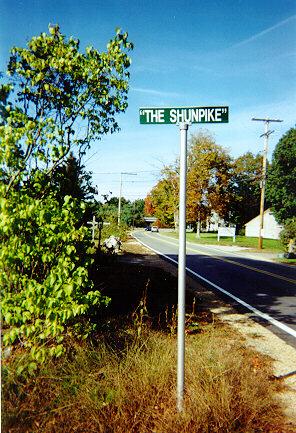(ca. 1810-1826)
By John M. Holman, Hampton History Volunteer

THE “SHUNPIKE” ….. When the “Turnpike” (sometimes known as “The Causeway” or “The Cassey”, now known as Lafayette Road or Route #1) was built around 1810 or so, by the Hampton Causeway Turnpike Corporation, from Drakeside Road to that part of Hampton Falls (known as “The Hill”), a toll was charged to cross it at Taylor’s River1.
Not content with the payment of a toll, some of the residents got together and built a slight bridge called the “Shunpike” across the Taylor’s River, some distance west of the Turnpike bridge, where travelers and teamsters could cross without charge. This continued on until April 12, 1826, when the toll on the Turnpike was discontinued and has remained a free road to this day.
The entrance to the “Shunpike” can still be seen today on the east side of the last house going west on Drakeside Road. This old road was also referred to on old maps as the “OLD ROAD” which passed by “Drake’s Brick Yard.” This road is now closed to all traffic as are Jonty’s Lane and White’s Lane.
[1 Originally, it was called “Tailor’s River” (see Chapter IX, Hampton Falls. 1709-1760, page 163 of Joseph Dow’s History of The Town of Hampton, N.H., 1638-1892. Then on page 164, same chapter, the river is referred to as “Taylor’s River”. Years later, unknown date, the “s” was dropped for whatever reason, and it became “Taylor River”, which remains such to this day.]
JOSEPH DOW’S HISTORY OF HAMPTON
(From it’s Settlement in 1638, to the Autumn of 1892)
Chapter 30 — Part 6
Proposed Road From Vittum’s Corner to Shunpike Bridge
“In 1821 the selectmen were petitioned to lay out a new road in Hampton, beginning at Vittum’s corner, so called, [junction of Towle Farm Road & Exeter Road] and running to the line of Hampton Falls at the shunpike bridge, so called. As they declined to lay it out, application was made to the Justices of the Court of Sessions. The town voted to use all laudable means to prevent the laying out of the road. Dr. Ebenezer Lawrence was chosen agent for th town, to make a defense at the Court of Sessions against the proposed road. The defense, however, was of no avail. The Court, by this committee, laid out the road. But this did not end the controversy.
“Another town meeting was held on the 16th of September, 1822, to see whether the town would be at any more expense to prevent the making of the road, which had then been laid out, and to defend the turnpike. The last clause in the above sentence is very suggestive. There are men now living, who well remember the bitterness of feeling, occasioned by the controversy about this road and one or two others not far from the same time. Some of the warmest advocates of this road admitted that their intention was to divert the travel from the turnpike, and thus break downs the Causeway Corporation. The opposers, generally, believed that the road was not needed for the accommodation of the public; and many of them, that the town would not be acting in good faith towards the corporation, erected by their agency, if they should countenance the building of any other road, intended to make the investments worthless to the stockholders.
“The town did not proceed to build the road laid out by the Court of Sessions.
“Proposed Road From North Hampton Line to Hampton Falls Line
“In 1824 another road was laid out by the Court of Sessions,s beginning at North Hampton line and running through Hampton to Hampton Falls line. As this was only part of a road, to lie in several towns, the Court had original jurisdiction, without any previous refusal on the part of the selectmen. In the judgment of a large majority of the legal voters, however, the portion of the road, as laid out across this town, if built, would not so well accommodate the public, as did the roads then in use. The route of the contemplated road was to a considerable extent so rough, and in other places so wet and miry, that it could not be built without great expense, nor easily kept in repair, if built. Hence, with very few exceptions, the citizens were opposed to the road, and the town refused to build it, — for which refusal, it was indicted, and an expensive lawsuit followed.
“At the annual town meeting, in 1825, the selectmen and the town agent, Dr. Lawrence, together with James Leavitt, Edmund Toppan and David Nudd, were chosen a committee, to consult with the directors of the turnpike, and to require them to call a meeting of the proprietors and others interested, to ascertain the lowest sum for which the corporation would consent to surrender the charter, to make the road a free one, to be kept in repair by the towns of Hampton and Hampton Falls.
“Eleven months afterward, the committee reported, that the corporation would relinquish to the two towns the Hampton Causeway Turnpike, and all their right to keep up any gate, and to take toll on the same, with the canal and ditches on the sides of said turnpike, not including, but reserving the buildings and uplands appertaining to the same, for the sum of five thousand dollars, to be secured to the shareholders at an interest of six per cent, payable annually; the principal to be paid by installments so apportioned, that the payment of the whole should not extend beyond six years.
“Both town agreed to the terms offered, Hampton paying three thousand dollars and Hampton Falls, two thousand, of the sum required. The business was satisfactorily concluded, and on the 12th day of April, 1826, the gates were taken down, and the turnpike became a free road.”